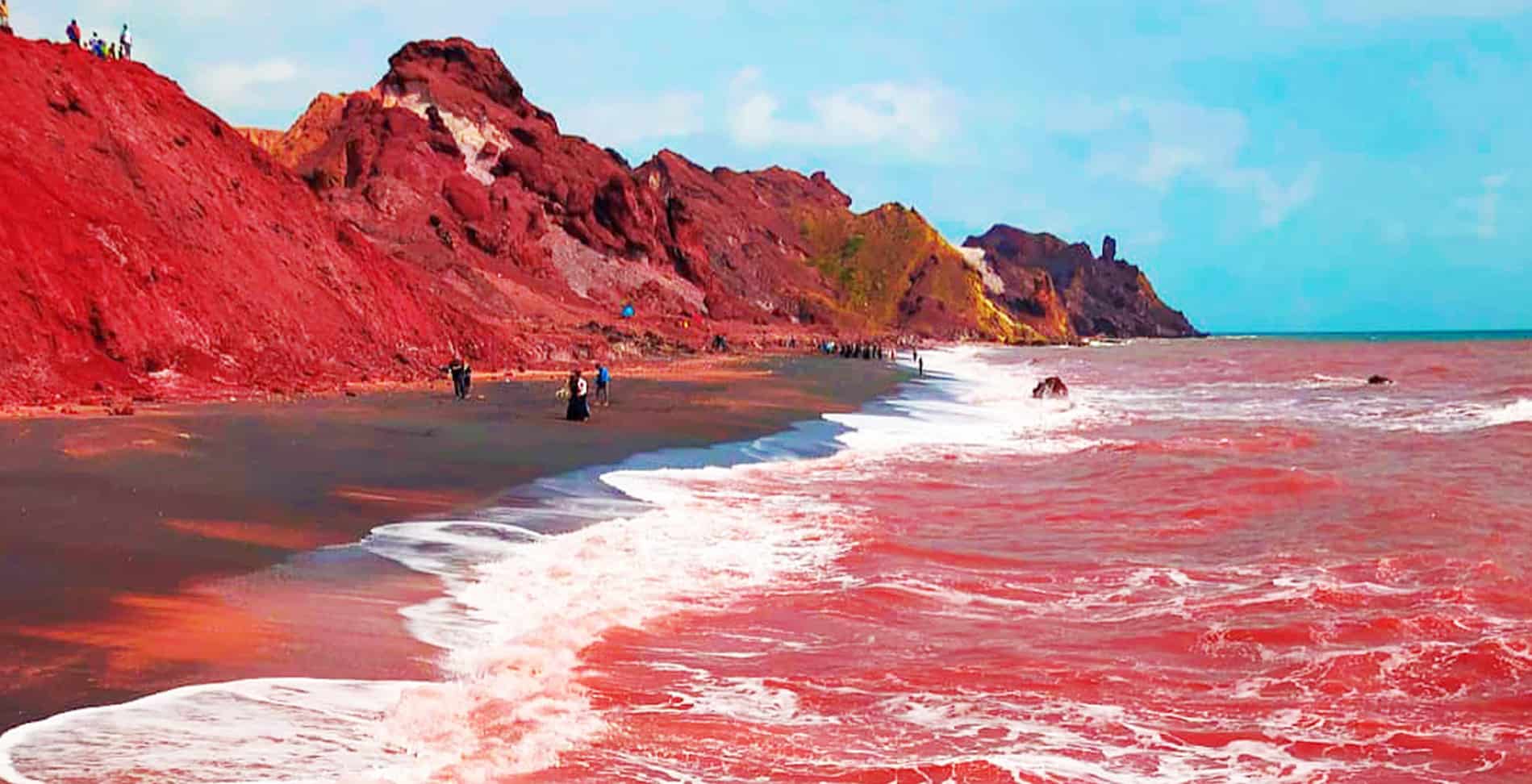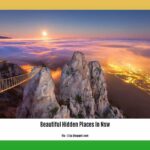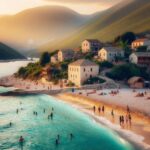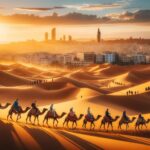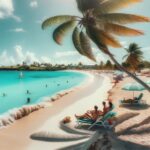Hormuz Island, a geological marvel in the Strait of Hormuz, captivates with its vibrant hues, earning it the nickname “Rainbow Island.” This comprehensive guide delves into the island’s formation, history, culture, and burgeoning tourism scene, offering practical tips for experiencing its wonders responsibly. Discover the magic of Hormuz, from its ochre-stained beaches and dramatic salt caves to the warm hospitality of its people.
Exploring the Geological Rainbow
Hormuz Island’s story begins approximately 600 million years ago, culminating in its dramatic emergence from the Persian Gulf around 50,000 years ago. This geological uplift revealed a salt dome, a unique formation composed of sedimentary rocks, volcanic materials, and iron oxide, the source of its dazzling colors. The reddish ochre, locally known as “Golak,” paints the landscape in shades of red, orange, and ochre, creating a visual feast for the eyes.
The Science Behind the Colors
The vibrant hues of Hormuz are a result of its unique mineral composition. The high concentration of iron oxide, a naturally occurring mineral, creates the dominant reds and oranges. Layers of clay and shale, compressed and folded over millennia, contribute additional shades and textures, forming a breathtaking tapestry of color. This geological rainbow is a testament to the power of natural processes and a fascinating subject for geological study.
A Journey Through Time
Hormuz Island whispers tales of ancient traders and echoes of empires. Stone artifacts unearthed at Chand-Derakht offer glimpses into the lives of the island’s earliest inhabitants. Its strategic location in the Strait of Hormuz, a vital maritime passage, made it a coveted prize throughout history. The imposing Portuguese fortress, a relic of colonial times, stands as a silent witness to this rich past. Today, Hormuz Island balances its heritage with its burgeoning tourism, carefully navigating the path between preservation and exploration.
From Ancient Port to Modern Marvel
Hormuz Island transitioned from a bustling trading hub to a relatively quiet community before experiencing a resurgence as a unique tourist destination. This shift presents both opportunities and challenges, requiring a delicate balance between economic development and the preservation of the island’s fragile ecosystem and distinct culture.
Experiencing the Soul of Hormuz
Beyond its “Rainbow Island” fame, Hormuz offers a rich tapestry of experiences. Walk the crimson sands of Red Beach, explore the echoing depths of the salt caves, and delve into the history within the weathered walls of the Portuguese fortress. Venture beyond the well-trodden paths to discover hidden geological formations, each a testament to the island’s dynamic landscape.
Discover the breathtaking remoteness of Ducie Island, another unique island destination.
Planning Your Hormuz Island Adventure
Getting There and Around
Reaching Hormuz is easy with regular ferries from Bandar Abbas, the closest port city on the mainland. The ferry journey itself provides stunning views of the Persian Gulf. Once on the island, taxis and motorbike rentals are available, but walking is arguably the best way to absorb the vibrant scenery and stumble upon hidden gems.
Where to Stay
Hormuz offers a range of accommodations, from budget-friendly homestays and hostels to more upscale eco-lodges and hotels. For the adventurous, camping under the starlit sky is an unforgettable experience. Remember to check tide charts if you choose to camp on the beach.
| Accommodation Type | Description | Price Range |
|---|---|---|
| Homestays/Guesthouses | Experience true Hormuzi hospitality and local life. | Budget-friendly to Mid-range |
| Eco-lodges | Sustainable accommodations often offering stunning views. | Mid-range to Luxury |
| Hotels | Provide traditional amenities and comforts. | Mid-range to Luxury |
| Hostels | Budget-friendly options; check availability beforehand. | Budget-friendly |
| Camping | Pitch your tent on the beach (check tide charts!). | Free |
Booking accommodations directly often provides a more personalized experience and may unlock local insights. You might also find listings on platforms like 1stQuest.
Hormuz Island: A Community in Color
Approximately 6,000 people call Hormuz Island home, a diverse mix of Persians, Arabs, and indigenous Hormuzis. Their lives are intertwined with the sea, with fishing as a traditional livelihood. Tourism is an emerging industry, offering both promise and challenges for the island’s future.
Life on the Rainbow Island
The daily lives of Hormuz residents reflect the island’s unique character. Some continue the tradition of fishing, while others are involved in the growing tourism sector or maintain traditional crafts. The future of Hormuz depends on sustainable practices that balance economic growth with environmental and cultural preservation.
Who Owns Hormuz Island?
Hormuz Island’s strategic location in the Strait of Hormuz, a crucial waterway for global oil trade, complicates its ownership. Iran has maintained de facto control since 1971, administering it as part of Hormozgan Province. However, the UAE asserts a historical claim, adding tension to the regional political landscape. The island’s location and the unresolved ownership dispute contribute to regional instability. This ongoing situation has implications for both local communities and international relations.
Sustainable Tourism: Protecting Paradise
Hormuz Island’s growing popularity necessitates responsible tourism practices. Supporting local businesses, minimizing environmental impact, and engaging respectfully with the local culture are crucial for preserving the island’s unique beauty and heritage for future generations.
Golak: The Earth’s Pigment and the Heart of Hormuz Art
Golak, the reddish ochre that stains the island’s soil, is more than just a pigment; it’s the heart of Hormuz’s artistic expression. Local artisans use Golak to create stunning paintings, textiles, and handicrafts, infusing their work with the island’s spirit. By supporting these artists, visitors contribute to the preservation of a unique cultural heritage.
Hormuz Island in Context
Hormuz Island is not the only salt dome on Earth, but its vibrant colors and unique mineral composition distinguish it. Comparing Hormuz to other salt domes provides a deeper understanding of its geological significance. Explore the charming lakeside town of Hammondsport, New York for a different kind of geological and cultural experience.
The Future of Hormuz
While much is known about Hormuz Island, ongoing research continues to unveil its mysteries. The island’s future likely hinges on a delicate balance between embracing tourism and preserving its unique environment and cultural heritage. Further research will undoubtedly enrich our understanding of this remarkable place and its people.
- Unlocking TEA Words: Comprehensive Analysis & Lexical Insights - April 29, 2025
- Unlock Sustainable Farming:Achievable Crop Yields Now - April 29, 2025
- Unlock Your Potential: Words With Inspiration for Lasting Success - April 28, 2025
